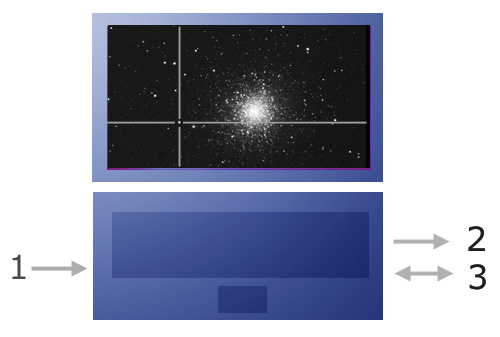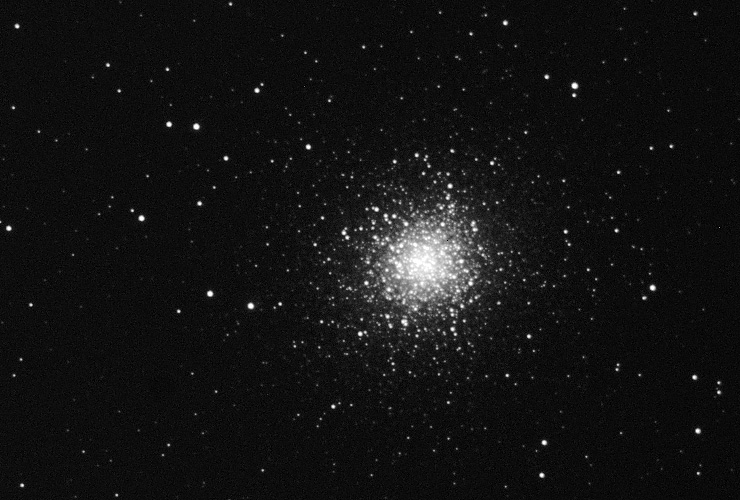The Starry Night, 26 :: home :: |
|
10/1/2010: I tried to get the Orion Solitaire back up to speed. It worked great for M13, which was a target of opportunity rather than my choice for the night. After I got the guider working, I wanted to take some relatively deep data of the Veil. I'd set the telescope up a little too far south and had to wait a couple of hours for the field to clear overhead tree canopies. I spent that time imaging M13, and eventually there'll be a deeper RGB image to show for it. For a guide star, I tried some field stars but settled on the bright keystone star near M13. The guidescope's PSF was dreadful, which likely contributed to difficulty finding a guidestar (I reassembled its lens to make sure spacers were oriented properly and that nothing was canted in the cell; issues may have been related to the focuser, see below). I slewed to the Veil and starhopped to the larger, fainter arc, but I had absolutely zero luck getting the guider to lock onto any stars. I shifted the guidescope as far as the bright star of Cygnus's wing that marks the beginning of the star hop to the Veil, but even that was not to the Solitaire's liking. Instead of fighting it out with a recalictrant guider, I ended up taking 120 sec unguided RGB subs. I had intended to make 1800 sec guided Ha frames. The RGB images are actually very promising (and would be better if I had not somehow cut off part of the nebula in the Green data). I wouldn't be surprised to see them here by and by.
10/2/2010: What I really took away from last evening was a detemination to solve the guiding problem once and for all. I dislike not being able to see what I'm guiding on and what the guider is doing. A few years back I enjoyed great success using a Meade DSI as a guide camera, but the cabling to a tiny Sony Vaio with only two USB 1.1 ports was extraordinarily cumbersome. I dug the DSI out along with the USB hub, relay box, GPUSB adapter, and a handful of cables. After breakfast, I sat at the table on the porch contemplating the bird's nest of cords. Came the dawn: with the A-P mount, I can do without the relay box, and with the Aspire One rather than the tiny Vaio, I have enough USB 2.0 ports to control the guider, the mount, and a camera without a hub; and without the hub I didn't need the extra power cord. So I was left thinking that this simple arrangement should suffice:
(1) The Meade DSI sends guide images in via the leftside USB slot (my numbering is arbitrary, but the same equipment should be consistently plugged into the same slots to avoid the need to reinstall drivers). (2) A Shoestring Astronomy GPUSB adapter sends guide commands to the mount via a phone cord. (3) The SBIG ST2000XM (or a tethered Canon or the Chameleon, whatever sensor you want to use) is connected via the third port. Does it really work as easily as that? You bet it does! I used Nebulosity for camera control and imaging and PHD for guiding. Both packages are from Stark Labs and play well together. NOW, I see why some people were mystified that others found the Solitaire an attractive concept: with the right mount and enough USB ports, computer-based guiding can seem really simple. The sky was hard blue all day and I was counting on shooting the Veil, so I moved the telescope with that subject in mind. Because I knew I was going to be experimenting with PHD for guiding, I intentionally left some slack in the new polar alignment. I wasn't off by a gross amount, but I wasn't nearly as close to the pole as I was last night (at a guess, I was 10 - 15 arcminutes off). I wanted to make sure PHD had something to do so I could judge the configuration and recognize success unambiguously. I started with M13 so I could have a direct comparison with recent results. Here's a five minute exposure of M13, without tracking (547mm EFL, cropped from full-res image):
Then I started PHD, selected the DSI, picked a guide star, let PHD calibrate the mount's motions, and then asked it to do its thing. Here's the next 300s:
That's a single 300s luminance frame with a dark frame subtracted. I did another 4 frames while clouds rolled in. All are tracked well. Four out of five are perfectly useful (one was ruined by clouds). Half a meter of FL is not exactly demanding, but this clearly works! I had problems with the guide telescope's Crayford focuser and disassembled it after I took the telescope down for the evening. A plastic bushing under the focus axle had apparently come loose: I focused by simlpy pushing the guide camera in and out, and later I "improved" the action until it would respond to the knobs but bind up every inch or so of travel. After dis- and reassembly, the Crayford works vastly better. It actually seems to have some muscle now, enough to lift the guider against gravity with the fine motion. This is good. Cable management in the dark is always a challenge. I made a cable clamp from a short section of PVC pipe and attached it to an Agena Astro Products ring clamp. This I mounted near the center of the guide telescope's tube. All the power and data cables associated with the imaging kit can be gathered up and passed through there where they share a common origin at the telescope and can be kept out of the way. As for PHD guiding, remember this: it's not enough to select "GPUSB" under the telescope tab. That just tells PHD what sort of mount interface it's going to be talking to. After you set that interface in the top menu, you still have to click the telescope icon down at the bottom to actually connect via your chosen interface. Advanced parms are hidden behind the brain on the lower right; "force recalibration" was the option I was hunting for. Short exposures (0.5 to 2 seconds, depending on the transparencey o'the moment), presented plenty of potential guidestars, probably down to about 11th magnitude. That's 50 to 100x fainter than what the Solitaire wants, so the 4-inch guidescope project is on hold. The mount calibrated routinely and tracked as you can see. That's the way you do it! As I finished up with M13 and turned to the Veil, a shelf of overcast slid in and slammed the sky shut. I've got no killer images tonight, but I do have a definitive guiding solution. That's a good deal. I'm off to TN for a couple of weeks, so it's especially good to have this worked out. I can look forward to putting it to work when I get home rather than waste any time worrying about what might work and what might not. I think this problem is solved. |
:: top ::
© 2010, David Cortner


